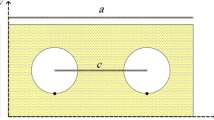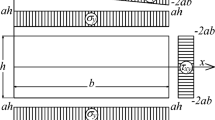Structural analysis of viscoelastic solid polymers is one of the most important subjects in engineering structures. Several attempts have been so far made for the integral equation approach to viscoelastic problems. From the basic assumptions of viscoelastic constitutive equations and weighted residual techniques, a simple but effective boundary element formulation (BEF) is implemented for the standard linear solid (SLS) viscoelastic models. The SLS model provides an approximate representation of the observed behavior of a real polymer in its viscoelastic range. This formulation needs only Kelvin’s fundamental solution of isotropic elastostatics with material constants prescribed as explicit functions of time. This approach avoids the use of relaxation functions and mathematical transformations, and it is able to solve the quasistatic viscoelastic problems with any load time-dependence and boundary conditions. As an application, a numerical example is provided to validate the proposed formulation. The problem of the pressurization of thick-walled cylindrical viscoelastic tanks made of PMMA polymer is completely analyzed by this approach.
Similar content being viewed by others
References
F. J. Rizzo and D. J. Shippy, “An application of the correspondence principle of linear viscoelasticity theory,” SIAM J. Appl. Math., 21, 321–330 (1971).
T. Shinokawa, N. Kaneko, N. Yoshida, and M. Kawahara, “Application of viscoelastic combined finite and boundary element analysis to geotechnical engineering,” in: C. A. Brebbia and G. Maier (eds.), Boundary Elements VII, Springer, Berlin, 2 (1985), pp. 37–46.
T. Kusama and Y. Mitsui, “Boundary element method applied to linear viscoelastic analysis,” Appl. Math. Model., 6, 285–290 (1982).
J. P. Wolf and G. R. Darbre, “Time domain boundary element method in viscoelasticity with application to a spherical cavity,” Soil Dynam. Earthquake Eng., 5, 138–148 (1986).
W. J. Sim and B. M. Kwak, “Linear viscoelastic analysis in time domain by boundary element method,” Comput. Struct., 29, 531–539 (1988).
A. Carini and O. De Donato, “Fundamental solutions for linear viscoelastic continua,” Int. J. Solids Struct., 29, 2989–3009 (1992).
S. S. Lee, Y. S. Sohn, and S. H. Park, “On fundamental solutions in time-domain boundary element analysis of linear viscoelasticity,” Eng. Anal. Bound. Elem., 13, 211–217 (1994).
E. Pan, C. Sassolas, B. Amadei, and W.T. Pfeffer, “A 3-D boundary element formulation of viscoelastic media with gravity,” Comput. Mech., 19, 308–316 (1997).
M. Schanz, “A boundary element formulation in time domain for viscoelastic solids,” Commun. Numer. Methods Eng., 15, 799–809 (1999).
J. J. Pérez-Gavilán and M. H. Aliabadi, “A symmetric Galerkin boundary element method for dynamic frequency domain viscoelastic problems,” Comput. Struct., 79, 2621–2633 (2001).
S. Syngellakis, “Boundary element methods for polymer analysis,” Eng. Anal. Bound. Elem., 27, 125–135 (2003).
S. Syngellakis and J. W. Wu, “Evaluation of various schemes for quasi-static boundary element analysis of polymers,” Eng. Anal. Bound. Elem., 28, 733–745 (2004).
Y. Huang, S. G. Mogilevskaya, and S. L. Crouch, “Complex variable boundary integral method for linear viscoelasticity,” Eng. Anal. Bound. Elem., 30, 1049–1056 (2006).
A. D. Mesquita and H. B. Coda, “A boundary element methodology for viscoelastic analysis,” Appl. Math. Model., 31, 1149–1185 (2007).
J. Wang and B. Birgisson, “A time domain boundary element method for modeling the quasi-static viscoelastic behavior of asphalt pavements,” Eng. Anal. Bound. Elem., 31, 226–240 (2007).
S. Syngellakis and J. Wu, “Evaluation of polymer fracture parameters by the boundary element method,” Eng. Fract. Mech., 75, 1251–1265 (2008).
H. Ashrafi, M. Farid, and M. Kasraei, Boundary Element Formulation for General Viscoelastic Solids, Proceedings of the 7 th Annual International Conference of Iranian Aerospace Society, Sharif University of Technology, Tehran, Iran, Feb. 2008.
H. Ashrafi, M. Farid, and M. Kasraei, “A new boundary element formulation for general viscoelastic solids,” Int. J. Aerospace Sci. Technol., in press (2009).
E. Riande, R. Diaz-Calleja, M. G. Prolongo, and C. Salom, Polymer Viscoelasticity, Marcel Dekker, New York (2000).
I. M. Ward and D. W. Hadley, An Introduction to the Mechanical Properties of Solid Polymers, John Wiley and Sons, Chichester (2004).
W. Flügge, Viscoelasticity, Springer, Berlin (1975).
N. G. McCrum, C. P. Buckley, and C. B. Bucknall, Principles of Polymer Engineering, Oxford University Press, New York (1997).
R. S. Lakes, Viscoelastic Solids, CRC Press, Boca Raton (1999).
L. E. Malvern, Introduction to the Mechanics of Continuous Medium, Prentice Hall, Englewood Cliffs, New Jersey (1969).
G. T. Mase and G. E. Mase, Continuum Mechanics for Engineers, CRC Press, Boca Raton (1999).
A. A. Becker, The Boundary Element Method in Engineering, McGraw-Hill, New York (1992).
M. H. Aliabadi, The Boundary Element Method (Applications in Solids and Structures), Wiley, Chichester (2002).
X.-W. Gao, “The radial integration method for evaluation of domain integrals with boundary-only discretization,” Eng. Anal. Bound. Elem., 26, 905–916 (2002).
J. C. Simo and T. J. R. Hughes, Computational Inelasticity, Springer, Berlin (1997).
G. Huang and H. Lu, “Measurements of Young's relaxation modulus using nanoindentation,” Mech. Time-Depend. Mater., 10, 229–243 (2006).
Author information
Authors and Affiliations
Corresponding author
Rights and permissions
About this article
Cite this article
Ashrafi, H., Farid, M. A mathematical boundary integral equation analysis of standard viscoelastic solid polymers. Comput Math Model 20, 397–415 (2009). https://doi.org/10.1007/s10598-009-9046-x
Published:
Issue Date:
DOI: https://doi.org/10.1007/s10598-009-9046-x




